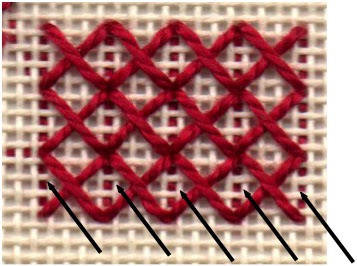Many geometric designs have a portion of the stitched design in which a couched thread goes all the way around the piece, in a square or rectangular shape. A decorative stitch holds down the couched thread. If I have not been too clear, this is what I mean:
 |
| Sue Reed's Harmony - Sea |
Many thanks to Sue Reed for letting me use her beautiful piece Harmony - Sea to make a point.
Some may wonder, just how do you turn a corner with a couched thread, when the couched thread has to go down into the same hole that it comes up in.
If I diagram out what I am working with it looks like this:
There are several ways to handle this situation and many ways not to handle this situation. The number one thing NOT to do is put a knot on the back of the piece at each corner to allow yourself to come up and go down into the same hole.
The most fundamental way to handle this situation is to start and stop your couched thread on each of the four sides separately. That is too much starting and stopping if you ask me, but it will do the trick.
A similar method, and I say similar because it leaves as much thread on the back as if you were starting and stopping your thread on each side, is to carry the thread along the back underneath where it will be couched. This is what I mean:
There is absolutely nothing wrong with this technique. It does leave a lot of thread on the back, but that thread will be tacked down by the same stitches that you use on the front to tack down the couched thread.
For those of you who do not want to have a lot of thread on the back there are other techniques to try: using a tacking stitch to turn a corner and backside couching. First the tacking stitch method:
For a close up of what is happening at the corners:
With this method, you bring your needle down into the hole marked “2”, take a tacking stitch (3-4) and then bring your needle up at “5”, which is the same hole as “2”. This method does not work all the time, especially with heavy threads because the tacking stitch will create a lump if the thread is too thick. Perhaps the couching stitch would hide the tacking stitch lump, and it may, but there is a third method that works well with heavy threads - the underside or backside couching stitch.
Here is how that stitch works - you need to work with two needles simultaneously, the couched thread needle and the couching thread needle. The couching thread needle goes up through the hole marked “a” in the canvas and then you loop the couching thread around the couched thread and take the couching thread needle down into the same hole, marked “a”. Pull on the couching thread until the area in which the couching thread loops around the couched thread “pops” through to the back of the canvas. You may then neatly turn the corner. The entire length of the couched thread stays on the front of the canvas (the couched thread needle never is taken to the back of the canvas until you get to the very end), only the little area with the loop around it is on the backside.
It may be easier to follow the diagrams than the written instructions:
The backside couching technique works best with a thicker couched thread, so that the two threads fit snugly into the hole and provides stabilization for maintaining stitch tension.















%2Bstep%2B1.jpg)






















